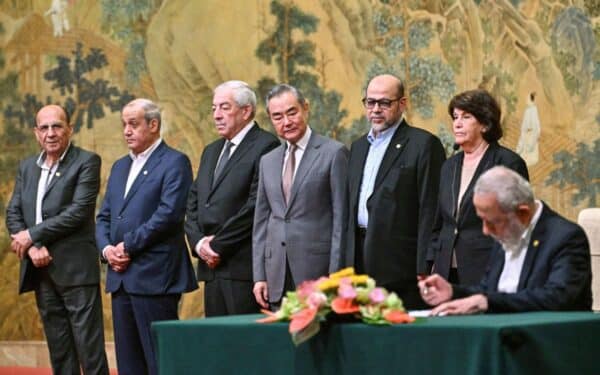The oppression of the Uighur people, the Turkic minority that have inhabited China’s far western region of Xinjiang for millennia continues unabated. By conservative estimates, at least one million are now incarcerated across a gulag of corrective, concentration and “re-education” camps across the province. That is around a tenth of the total Uighur population of 11.3 million in China. Some estimates suggest that one and a half million are now being held in the camps, including other Muslim minorities.
In July this year, 22 nations, including the UK, Canada, Australia, and Japan signed a letter to the UN Human Rights Council demanding the camps be closed immediately. But 38 countries, including Saudi Arabia sent a counter-letter to the UNHCR praising China for its “remarkable achievements in Xinjiang.” In February this year Crown Prince Mohammed bin Salman defended the use of camps as “China has the right to carry out anti-terrorism and de-extremism work for its national security.”
Conspicuously, the Organisation of Islamic Cooperation has failed to come to the aid of its co-religionists of the Uighur Muslim community. Gulf countries, including Iran, won’t touch the subject at all, so dependent are they on China for purchasing their energy output and inward investment.
The present crackdown, and the institution of the camps, began in 2014, and was boosted by a new provincial Communist Party Secretary, Chen Qanguo, in 2016. He had been promoted from a similar post in Tibet where he had been credited with success in an aggressive “Sinification” programme, imposing Chinese values, standards, and repressive politics. The inmates of the camps are made to speak and undergo political indoctrination in Mandarin. There are some reports of them being forced to eat pork and drink alcohol. In Xinjiang, the Beijing regime stands accused of a concerted campaign of cultural eradication. The Uighur Turkic language and literature are suppressed, and Islam frowned upon and worse. Mosques and churches have been destroyed. Halal butchers and shops have been closed.
The camps are described in terms of an Orwellian nightmare – torture, enforced abortions, kidnaps, disappearances, and enforced internal exile to elsewhere in China. This has been accompanied by deliberate pressure on the Uighur diaspora of about a million strong. Email and social media contacts are meticulously and minutely monitored, and then used to compromise the Uighurs at home.
The story of the Uighurs and China has a deep, rich and highly complicated past. The Uighurs emerged as one of about twenty different Turkic groups, each with a distinct language or dialect, about two millennia ago. They continuously challenged the power and authority of the Chinese establishment to the east. From the 8th to the 9th centuries of the Common Era, they boasted their own powerful Khaganate, which for the subsequent two centuries became the Uighur Kingdom.
Sometime during the Khaganate, the Uighur communities adopted Islam – it was a gradual process by osmosis more than a compelled conversion. Even with the arrival of Islam, their culture remained surprisingly humanistic, with figure portraits, ballads and music, and open and airy interior design and architecture.
The 2005 Royal Academy exhibition, Turks – a thousand years of civilisation 600 – 1600 CE – showed some extraordinary examples of Uighur art, portraiture especially. My favourite was a double portrait of a Uighur man and woman from a Xinjiang mural of the 12th Century CE. The label simply said “examples from Uighur culture, a remote medieval Turkic people”, or words to that effect. The show was sponsored by the Turkish government, and Recep Tayyip Erdogan’s AK Party had just won power. Erdogan doesn’t like the Uighurs, though he likes to talk of the “great family” of Turkish and Turkic peoples. He much prefers the family of his new friend – the president and leader-for-life Jinping.
As much as history, and the catalogue of past confrontation, it is geography that makes Beijing so sensitive to the role of the Uighurs in Xinjiang, China’s largest, most remote, and most westerly province. Roughly the size of Alaska, it forms the bridgehead of the ancient Silk Road. Jammed between the Gobi Desert and the great northern steppe, it commands access to the two main western routes of the road, one going south to Balkh in Afghanistan and into India and the sub-continent, and north towards the Aral and Caspian seas and via Bokhara to the shores of the Mediterranean. Today the new strategic Silk Road Railway runs through Xinjiang.



